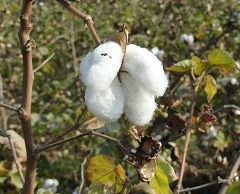
According to U.S. Department of Agriculture's (USDA) October Crop Production report, the 2012 U.S. cotton crop is estimated at 17.3 million bales, up marginally from last month's forecast but 1.7 million bales (11 percent) above the 2011 production. With harvested area unchanged in October and the national average yield slightly higher, the U.S. cotton crop estimate increased 178,000 bales this month.
The U.S. upland cotton crop is estimated at 16.6 million bales, above both last season and the 5-year average. During the previous 20 years, the October forecast has been below final cotton production 12 times and above 8 times. Past differences between the October forecast and the final production estimate indicate that chances are two out of three that the 2012 U.S. upland crop will range between 15.8 and 17.5 million bales.
Upland production this season is forecast to rise for two of the Cotton Belt regions this season. In the Southwest, the 2012 upland cotton crop is projected at 6.3 million bales, considerably higher than last season's drought-reduced crop but near the 10-year average.
Planted area abandoned is estimated at 26 percent, near the 5-year average, while the Southwest yield is forecast at 591 pounds per harvested acre, nearly 100 pounds below the average. In the Southeast, the cotton crop is estimated at 5.1 million bales, the highest in 7 years, as the regional yield improved to a record 900 pounds per harvested acre. The Southeast cotton crop has risen for five consecutive seasons.
In the Delta, the crop is currently estimated at nearly 4 million bales, down from last season but equal to the 5-year average. The average yield is expected to reach 967 pounds per harvested acre, the third highest on record. Likewise, in the West, the upland cotton crop is forecast at 1.2 million bales, down from last year but above the 5-year average. The West's yield is projected at a record 1,542 pounds per harvested acre. In addition, California continues to account for most of the extra-long staple (ELS) crop. ELS production is forecast at 657,000 bales, 23 percent below 2011, with California contributing more than 95 percent of the total.
Total 2012 U.S. cotton harvested area is estimated at 10.4 million acres, about 1 million acres above last season, despite a lower planted area. The national yield is forecast at 795 pounds per harvested acre, 5 pounds higher than the 2011 yield but 19 pounds below the 5-year average.
2012/13 Demand and Stock Estimates Adjusted
The U.S. cotton demand estimate for 2012/13 was lowered slightly this month as higher foreign production and reduced imports—particularly by China—are projected to keep U.S. cotton demand from expanding from last season. U.S. demand is currently forecast at 15 million bales, with exports accounting for 11.6 million bales (77 percent of the total) and mill use contributing the remainder.
Foreign stocks jumped dramatically last season and begin this season at a record 66.2 million bales; however, over 45 percent of the total is estimated to be held by China, where national reserve policies account for the buildup. Meanwhile, forecast imports by China are down by more than 50 percent, which will reduce world trade this season. The U.S. share of world trade is forecast at 32 percent, above last season but below the 5-year average of about 36 percent.
As a result of the latest supply and demand estimates, U.S. ending stocks were revised upward in October to 5.6 million bales, two-thirds more than the final 2011/12 ending stock estimate. The stocks-to-use ratio is forecast at 37 percent compared with last season's 22 percent. Both the stock level and the ratio are at their highest in 4 years.
2012/13 Farm Price Range Narrowed; 2011/12 Price Finalized
Based on the most recent prices and the latest supply and demand estimates, the average upland cotton farm price is now forecast to range between 62 cents and 74 cents per pound. The midpoint of 68 cents would represent a considerable decrease from last season's final estimate of 88.3 cents per pound released by USDA in October. The 2011/12 price was nearly 7 cents higher than the average price recorded for 2010/11. The lower price expectations for 2012/13 contributed to reduced cotton area and will play a key role in acreage decisions for 2013.





